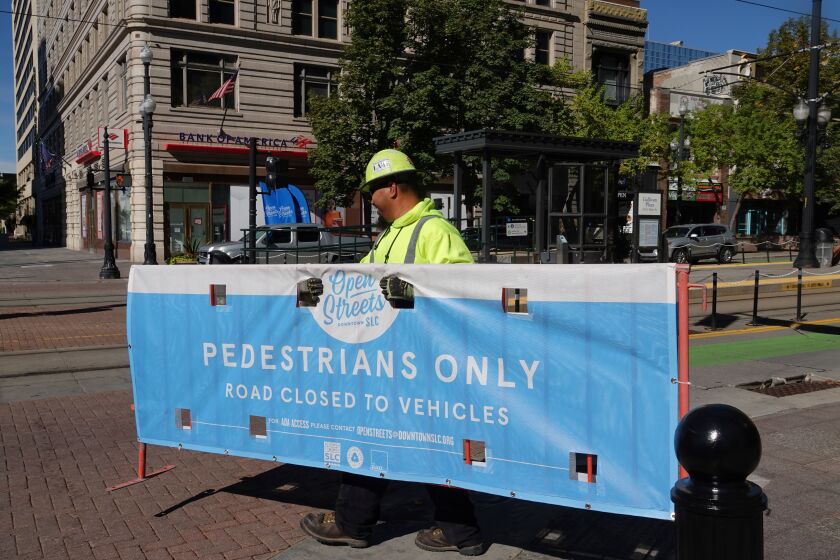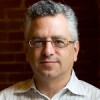In Brief:
Blair doesn’t have to go in to work. In fact, he lives about 700 miles from his office. Blair is an accountant and his work could easily be done from home. Nonetheless, most days he makes the trip into downtown Salt Lake City to work in a satellite office of his San Francisco company. If he didn’t come in, he says, he’d miss opportunities to exchange knowledge with peers, superiors and the younger people coming up behind him. “Doing it remotely would be very tough when it comes to actually learning and growing,” Blair says.
This type of attitude was once the norm, but it’s become less common in the era of remote work. Blair is certainly not alone, however, in seeing the value of interacting with his coworkers in person, at least most days. At 8 a.m. on a Thursday morning, the two-story atrium lobby of Blair’s office building is filled with the recurring sound of digital chimes as workers swipe in and their key cards are approved, with the line for lattes at Alpha Café, just off the lobby, a half-dozen deep.
A study from the University of Toronto earlier this year found that Salt Lake’s downtown had had the strongest post-pandemic recovery in unique-visitor foot traffic of any city in the country, based on cellphone data. In a follow-up, researchers expanded the footprint of what they consider downtown Salt Lake City considerably. That dropped the city quite a few spots in the rankings, down to 23rd (including some cities in Canada). Still, it’s clear that Salt Lake’s downtown is doing a lot better than many larger cities.
Not Just Office Workers
Despite the relatively strong presence of office workers, the reality is that Salt Lake’s downtown is less focused on them than many other cities. The region’s office space is spread out to other parts of the city, as well as neighboring jurisdictions, making Salt Lake less office dependent. About a quarter of the region’s office space is downtown, compared with almost half in Manhattan.
What Salt Lake City has that its immediate neighbors lack are cultural amenities and tourism. Visitors taking a break from nearby ski slopes are drawn not only by the state Capitol and Temple Square, the center of the Church of Jesus Christ of Latter-Day Saints (LDS), but restaurants, sports, shopping and music. Lots of people watch the Utah Jazz, but on any given weekend, non-sports fans might attend the symphony or a rock concert or even a Peruvian diva’s performance, or sit outside at restaurants during the warmer months, when several blocks of Main Street are closed off to car traffic.
Last year, 61 percent of the people drawn into the central business district came not for work but for arts and entertainment, tourism and conventions, according to Salt Lake’s Downtown Alliance. And people aren’t just coming to visit, but to stay. The downtown is dotted with construction cranes, with massive new apartment buildings going up seemingly around every other corner.
The pandemic helped turn Salt Lake City into more of a destination. Before the pandemic, two-thirds of Utah’s growth was natural, meaning births were strongly outpacing deaths. Since the pandemic, Eskic says, that’s flipped. Now, 61 percent of state growth comes from net migration, with 39 percent resulting from births outpacing deaths. A sizable chunk of the newcomers are in their 20s or 30s — exactly the cohort that’s been leaving San Francisco.
Salt Lake City’s housing plan sets a goal of 10,000 new units by the end of 2027, with a high concentration of that growth set for downtown. In fact, the population downtown is expected to double over the next three years, based solely on projects already underway or in the pipeline.
The housing market has cooled a bit, but it’s still under considerable strain. Longtime residents are shocked by how much rents and housing costs have gone up since the start of the pandemic. “The unintended consequence of having a great economy in a great region,” Eskic says, “is your housing demand surges.”

Surrounding Temple Square
During the day, alongside the office workers, people downtown walk their dogs or even ride bikes with their kids. Many visitors say they appreciate how clean and safe the downtown feels, including a man from Massachusetts named Jonathan carrying a takeout order back to his hotel. “I’ve just kind of been sightseeing on my own,” he says.
Kevin Earl gives walking tours of downtown Salt Lake, pointing out historical evidence of its role in women’s suffrage and as a stop for the Pony Express. He normally meets guests at the Brigham Young Monument, but with Temple Square fenced off for construction he stands waiting across the street.
Downtown Salt Lake is still influenced by the LDS pioneers, he points out. Starting from scratch, Young laid out the city’s grid system, with streets wide enough for mule teams to make easy U-turns. Young and other founders weren’t just interested in religion, Earl notes, but other community needs including government, banking and even breweries.
That kind of easy-proximity mix is what downtowns have historically been all about. The old model is clearly threatened by remote work, but that makes fostering mixed use only that much more important. Salt Lake used to have an eight-hour downtown that relied primarily on office workers. That changed with the 2002 Winter Olympics, which brought in light rail and helped spark the downtown housing boom.
Even with remote work, the most important thing cities have to offer is housing near jobs, says Tracy Hadden Loh, a researcher with the Brookings Institution. Most jobs still require at least occasional check-ins at the office, so short commutes remain selling points. “Abundant housing both in and around the downtown is something that’s important for the vitality of cities,” she says. “Overall, housing accessibility to the downtown is clearly structurally higher in Salt Lake City than in other regions.”

Great Rates for Out of State
Housing isn’t exactly abundant in Salt Lake just now, but more units are coming online all the time. Construction is mostly complete at a massive, 580-unit complex on the edge of downtown called Live at Post, which includes not just apartments but restaurants, retail and the headquarters of Traeger Grills.
A few affordable studios filled up fast. The building’s showplace apartment is a split-level, top-floor apartment with skylights and mountain views. That two-bedroom apartment rents for $5,600 a month, although most units are considerably cheaper, with one-bedrooms starting at $1,600. “For people who are born and raised here, it’s a little bit of a price shock,” says Christopher Sullivan, Live at Post’s property manager. “But for people coming in from around the country, it’s amazing.”
For a higher-end crowd, it’s no longer enough to offer a pool and a gym. Live at Post has all that, but also billiard and poker tables, an infinity hot tub, a golf simulator and a video theater that seats 20. Anticipating many residents will be working remotely, there’s a business center with conference rooms and glass-walled private offices, with a “branded scent that we pump in.”

“We are seeing a lot of movement from out of state,” Sullivan says. “Whether it’s young or old, everybody wants to live downtown.”
Related Articles














